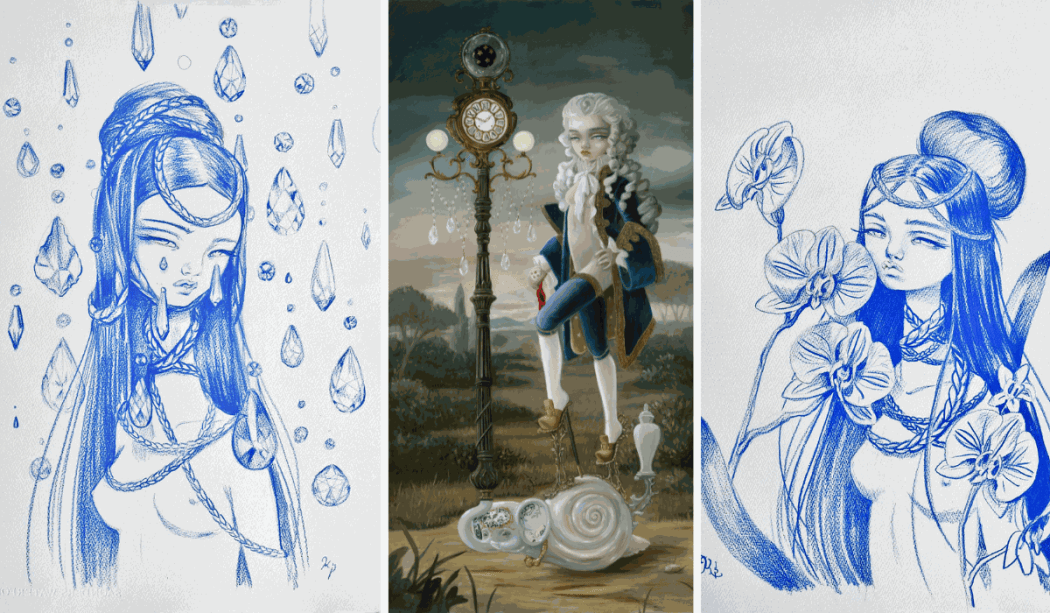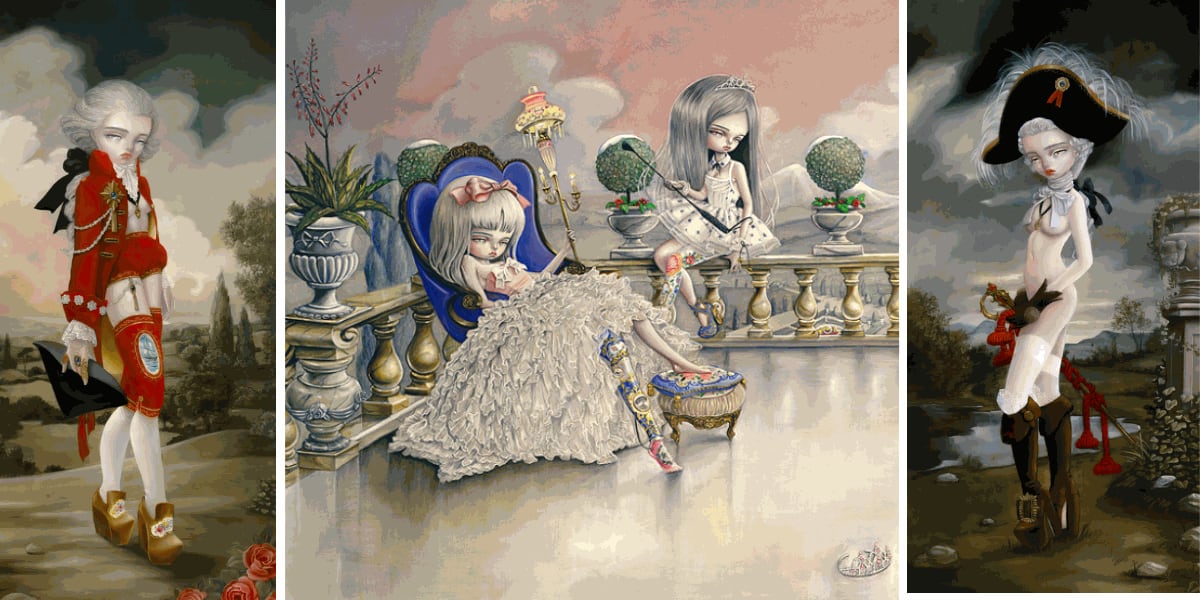
Recently inaugurated at DCG in London is "Nocturne in Blue Minor," the new exhibition by Kukula. This show features three of the largest works ever created by this extraordinary artist, a prominent name in the Pop Surrealist firmament. In over twenty years of her career, Kukula has distinguished herself with her ecstatic and evocative imagery.
Kukula's art narrates a contemporary romanticism that evokes both the idyllic atmospheres and the refined lightness and creativity of Rococo. Her inspiration is rooted in a deep desire to breathe the dreams of past eras, intertwining their symbolism and poetics with a quest for a vision of the future. This vision, inherent in the 19th century, is equally rich with dreams and promises that today seem to have been scattered by the wind.
With this curatorial insight, we aim to immerse you in the magical world of Kukula, allowing you to better appreciate her unique and enchanting work.

A JOURNEY IN THE HISTORY OF KUKULA
Nataly Abramovitch, known as Kukula, is a multidisciplinary artist living and working in the United States. Renowned as a Pop-Rococo artist, Kukula masterfully blends inspiration from classical European art with contemporary pop culture in her oil paintings.
She creates fantastical scenes with a lively yet realistic approach, characterized by intricate and whimsical details. Her paintings often echo traditional portraiture, depicting doll-like female figures immersed in idyllic landscapes, surrounded by objects with symbolic meanings that can sometimes be clear and other times mysterious.

As a child, she spent most of her time practicing ballet and studying music, particularly the piano. However, ballet and piano were not her true path. She would later find her calling in art.
Her career began with the production of a prêt-à-porter clothing line featuring her illustrations. She named this line Kukula, which sold well and led her to hold a small art exhibition in one of the stores where it was sold. However, that exhibition marked the end of her clothing production for a few years, as she felt a strong desire to focus solely on painting.
Throughout her artistic career, Kukula has collaborated with luxury designers. In 2015, she worked with MRZ-Marziali on a limited capsule collection, and in 2016, she collaborated with RED Valentino, creating unique pieces featuring her signature doll-like figures.

THE POETRY OF KUKULA: BETWEEN AN IDYLLIC PAST AND THE CONTEMPORARY WORLD
With an impeccable use of colors, shapes, and details, Kukula creates a unique artistic harmony that captures experiences and offers a profound feminine perspective. Her works, transformed into dreamlike visual narratives with androgynous forms, symbolize freedom of gender and self-perception. Through fragments of joy and sweet memories, her art reveals the most intimate secrets of a story, blending past and modernity with a touch of Rococo, bringing to life an enchanted and precious universe.
Kukula loves to create a fantastic world in her works that contains a bit of reality.
Kukula's world is made of graceful maidens, flowers, Rococo decorations, ribbons, lollipops, and fantastic creatures born from her imagination. The women she paints are princesses of a dreamland, dressed in marvelous gowns reminiscent of French and English portraits from the 18th century. Her figures are often set against natural yet fairy-tale-like landscapes, enjoying simple pleasures, whether alone or in company.
Drawing inspiration from the dramatic and decorative art of the 18th century, Kukula's work blends Pop Surrealism with influences from icons like Marie Antoinette and takes cues from artists such as François Boucher, Thomas Gainsborough, Reynolds, and Nattier.
Kukula's paintings, centered around doll-like female figures, are often rich with symbols. In her art, she masterfully combines classical European art with contemporary pop culture. Her figures evoke traditional portraiture but with a modern style influenced by pop culture.
Additionally, her paintings reflect her personal struggles. Kukula's works are unique, combining beauty, melancholy, innocence, and eroticism. Each character has a story, told through the image and the surrounding details.
Her creative process is primarily intuitive and involves historical and contemporary research into images that resonate with her. When she encounters an image that deeply moves her, she delves inward to explore what about it evokes such strong emotions. Through this introspective exercise, she continues to refine her ability to communicate her ideas and vision more clearly.

In both her work and as a person, there's always a play between intense emotions and lightness in Kukula's approach. She can experience deep feelings and easily drift into melodrama, yet she also embraces the absurd. In each painting, she strives to convey the complexity of various emotions: for instance, the background might set a serious and melancholic tone, while the foreground figure is adorned with extravagant golden floral decorations and accompanied by a fantastical creature.
In her works, therefore, something unique and evocative is created, with elements that might initially seem contrasting but ultimately blend together perfectly, creating fascination.
Despite the duality present in her artworks—such as light and darkness, frivolity and depth, or sensuality and innocence—there is always a balance. This balance allows her creations to resonate deeply with viewers, inviting them into a world where contradictions coexist harmoniously, enriching the narrative and emotional depth of her art.

Kukula is a devotee of the Romantic era, as she deeply believes in art's ability to convey what words cannot, often embracing emotional contradictions.
Her art is a medium for expressing feelings and emotions, aiming to evoke them in viewers. Through meticulous choices of colors, objects, figures, poses, landscapes, and other elements, Kukula communicates an entire emotional universe to her audience. Her work goes beyond mere visual representation, seeking to provoke a visceral response and immerse viewers in a world where emotional complexity and depth reign supreme.
THE ENCHANTMENT OF A VIVID IMAGINATION AND A RICH INSPIRATIONS
Kukula's inspiration for her works springs from her imagination and her study of costumes and fashion from past epochs, equally nourished by tales of princesses and real-life experiences, both as a woman and a mother.
Additionally, manga and anime have been a significant influence on her since childhood, particularly because most television programs in Israel during the 1980s were Japanese anime. This early exposure to anime has left a lasting impression on her artistic style and storytelling approach, blending elements of whimsy, narrative depth, and visual flair into her unique artistic expression.

However, her main source of inspiration is travel, as it exposes her to different places and cultures. For her, taking a break from creation is what gives her the impulse to create again.
Quoting the artist:
"I believe that art is always about taking inspiration and influence from the outside and projecting it back. I can’t imagine how you could create out of a black empty vacuum of nothing. Nature, history, culture and everything outside of you creates more art and invention. What makes humanity different from other creatures on this planet is the chain of knowledge embodied in innovative things that document and pass on that knowledge so that the next link can be forged and added.”
The ideas for her works derive from her observation of the world, artworks, painters, and much more. She draws much inspiration from objects created in the 18th century, particularly clocks and teacups. In fact, clocks and teacups often appear in her artworks, including those in her latest series.
In "The Judge," for instance, we find a marvelous enameled clock decorated with stars, an accessory but also a "burden," as the artist herself defined it, for the protagonist.
Kukula admires artists who are lavish in their details and those who embrace luxury without taking it too seriously.
This is why she particularly appreciates paintings from the 18th century, where many aristocrats were depicted in sumptuous attire yet maintained a sense of lightness and whimsy. Artists like Gainsborough, for example, had a delicate touch that she finds appealing.

ART AND FASHION IN KUKULA'S WORK: AN INSEPARABLE DUO
As we've already seen, fashion holds great significance for the artist.
Kukula draws much inspiration from theatrical performances because she sees life as though each of us plays a role that can change daily depending on our mood, and this role can be perfected through clothing. Therefore, this aspect is crucial both in everyday life and in her artistic creation. In all her works, we find her subjects adorned in incredibly detailed and elaborate garments, which can either reveal or conceal the female form to varying degrees.
In some of her works, equal attention is given to both the clothing details and the subject itself. Clothing, in fact, adds more personality to the image, becoming a fundamental part of the painting.
In her latest production, female clothing has made way for 18th-century-inspired male attire. However, her creatures always remain feminine.
They are not exactly dolls. To her, they are more creatures of the imagination, drawing more from manga and anime than anything else.
These figures are always surrounded by numerous symbolic objects, which can sometimes be challenging to decipher. Her world is magical and dreamlike, transporting us to a dimension where Japanese inspirations, as well as Western influences from the 18th century, blend with contemporary elements.

The complexity of her works indeed makes them so incredible and mysterious. To closely examine a Kukula artwork is to lose oneself in gardens inhabited by beautiful creatures whispering something in our ears. It means viewing femininity in a new light and appreciating all its nuances.
KUKULA AND THE FEMININE
In her paintings, Kukula has the ability to blend eroticism and innocence in a truly innovative way.
The young women she portrays may be scantily clad, partially revealing their bodies, yet they maintain an air of purity and innocence, despite sometimes being provocative.

In them, there is the innocence of youth, yet also an awareness of their femininity and feminine power.
The theme of femininity holds deep significance for the artist, and she explores it in various ways. However, her dreamy and romantic vision, infused with a Rococo touch, remains distinctly recognizable, making her unique and unparalleled in the world of pop surrealism.

“Nocturne in Blue Minor,” her latest exhibition, invited viewers into a dreamlike landscape of historical whispers and contemporary emotions.
Indeed, the artist's aim is never to remain within a single time or place. Kukula desires for the viewer to experience a sense of immortality, where through her works, the past resides within the present. In her creation, time becomes liberated, fluid, and blurred.
Through her artworks, we can escape from reality, immersing ourselves in a realm that transcends the simple distinction between present and past, projecting us into another dimension characterized by ethereal beauty and dreamy atmospheres.


